

Henry Kemp Partleton (1814-1893)
Eliza Cooper (1820-1882)
The story of Henry Partleton is going to lead us to some strange places. But we should start at the beginning. Henry, the son of Benjamin Partleton (b1774) and Catherine Iremonger, was christened with his brother George at the church of St James Westminster aka St James Piccadilly, on Monday 24 October 1814:
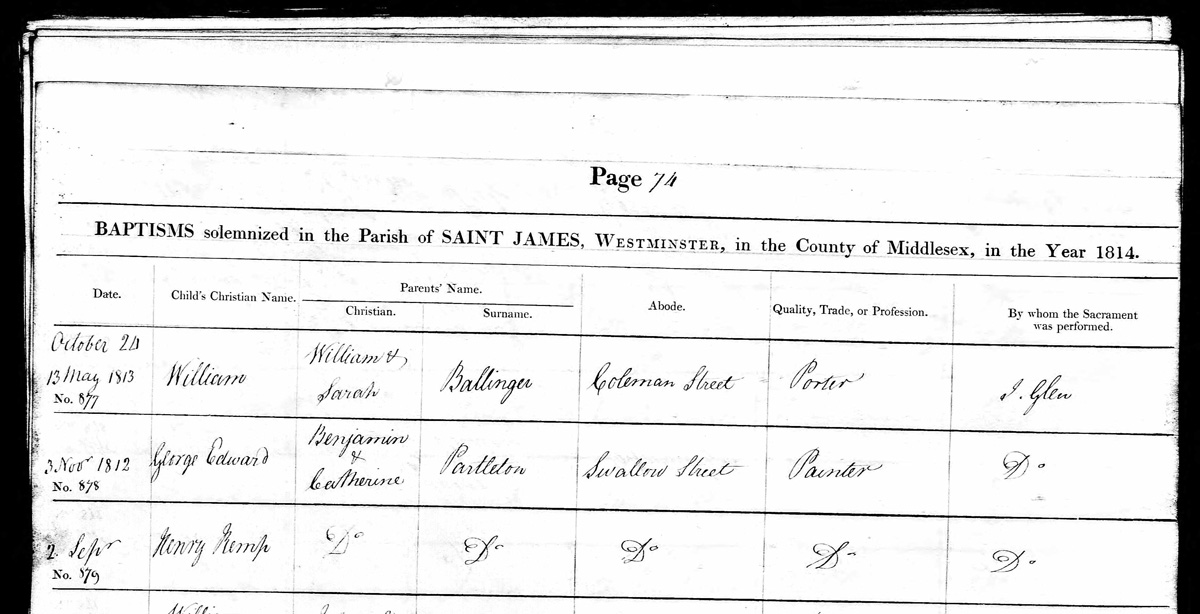
Ah yes, the church of St James Westminster, on fashionable Piccadilly, a place we've seen many times in these web pages, but I'm not going to skip over it, because there's always something new if you look for it, so we'll have another quick look at it.
Henry's middle name is unusual: Kemp. It's a genealogical clue. Middle names were often used to preserve the mother's (or grandmother's) maiden name. Well, his mum was Catherine Iremonger and his paternal grandmother was Hannah Dunsdon. But we don't know who his maternal grandmother was, and I think it's a fair bet that her surname was originally Kemp.
The place of birth is Swallow Street; if you haven't seen where Swallow Street is on other pages on this website, here's a reminder:

So, let's deal again briefly with St James Church, Piccadilly. Below are a couple of pictures of the font [sculpted in 1686] in which Henry was christened, depicting the Garden of Eden. On the left is a 1718 engraving, nearly 100 years before Henry's baptism, and on the right a modern photograph, approaching 200 years after Henry had his head dipped - it's still there in the church just as it was for Henry's christening:
 Left: 1718 Right: 2008
Left: 1718 Right: 2008

Here's a picture of the church of St James Piccadilly. Piccadilly was a busy, commercial street... the man with the placard is not a protestor, he's advertising something!:
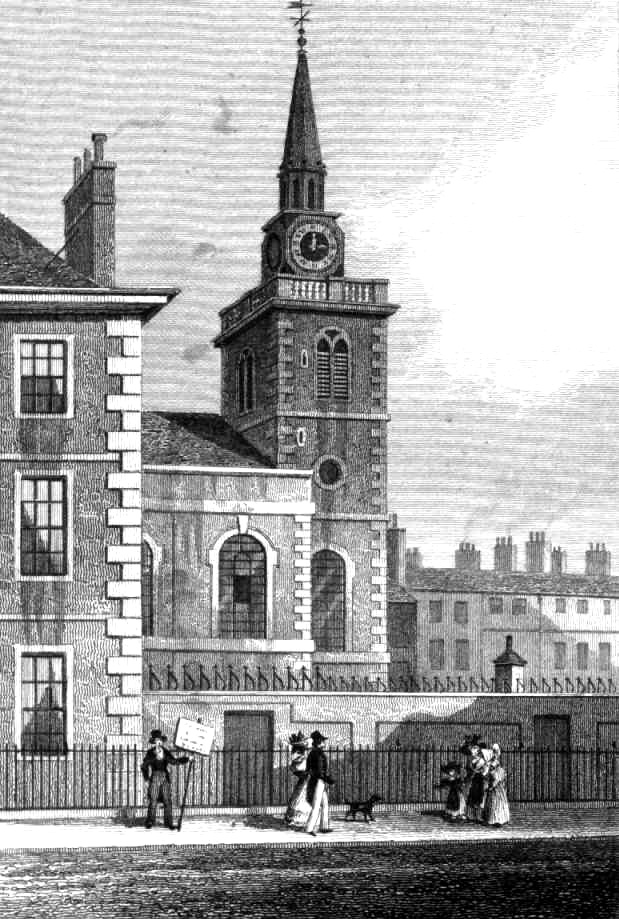
In the map below, we see, circled in blue, the exact location of the house where Henry was born - 43 Swallow Street - and the the viewpoint of the artist for the above picture, from the red arrow:
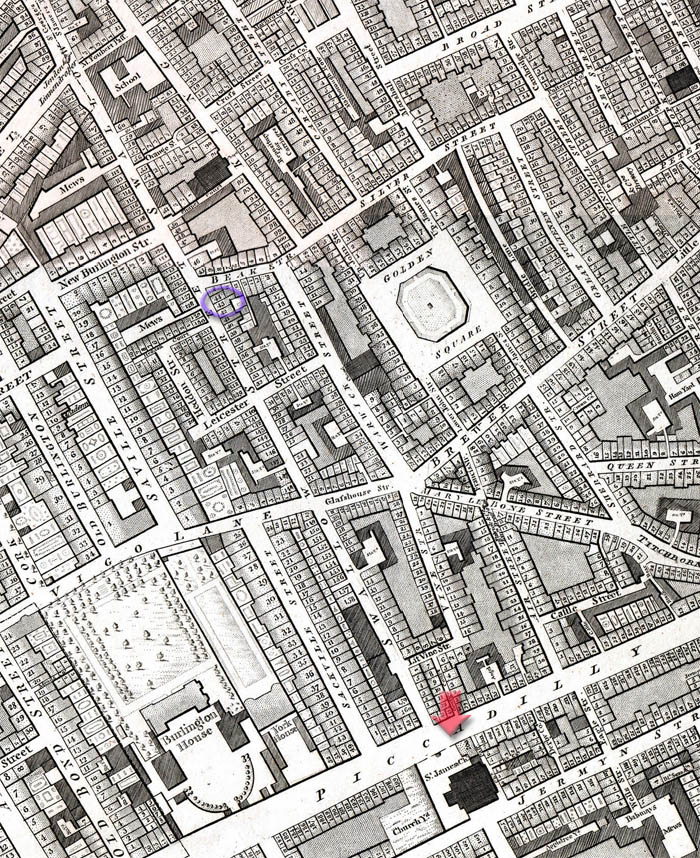
The exterior of St James Piccadilly is somewhat dull, but the interior of this church, built in 1688, and designed by Sir Christopher Wren - one of his favourite designs - is very grand. Here it is in 1806:

And here it is now (2008):

Henry's dad Benjamin is officially a house painter, but he seems to have been a rather pushy dad, or perhaps Catherine Iremonger was a pushy mum, because Henry is born into a family of young performers, as we shall see.
I wonder what Benjamin and Catherine, with their love of the show business, would have made of what we see below - Michael Stipe and supergroup R.E.M. holding a secret unadvertised gig in the church, for selected fans - 189 years, 11 months, 22 days after Henry's christening:


So, what about Henry? As our family-tree historical evidence accumulates, it is becoming becoming increasingly apparent that all of his Partleton brothers and sisters - there were 8 of them - went on stage in London. They were actors, comedians, dancers, musicians and singers.
As for Henry himself, the first evidence we have about his young life is - ironically - from his obituary, reported in a newspaper on 06 May 1893:
,%20Saturday,%20May%206,%201893r.png)
So, we go rapidly back to 1823 where Henry performs at Astley's Amphitheatre, at the tender age of 9. By this date Henry's childhood residence on Swallow Street has been demolished as a part of the creation of Regent Street, and he has relocated with his family to Lambeth on the south bank of the River Thames.
Here's what Astley's looked like; in this engraving, it has a huge overblown show-carriage in front, as a stunt, pulled by fourteen horses:

The view above was drawn by artist W H Miller from the viewpoint of the red arrow in the map below.
Astley's was directly opposite Westminster Hall aka the Palace of Westminster aka the Houses of Parliament, circled blue across the river Thames:
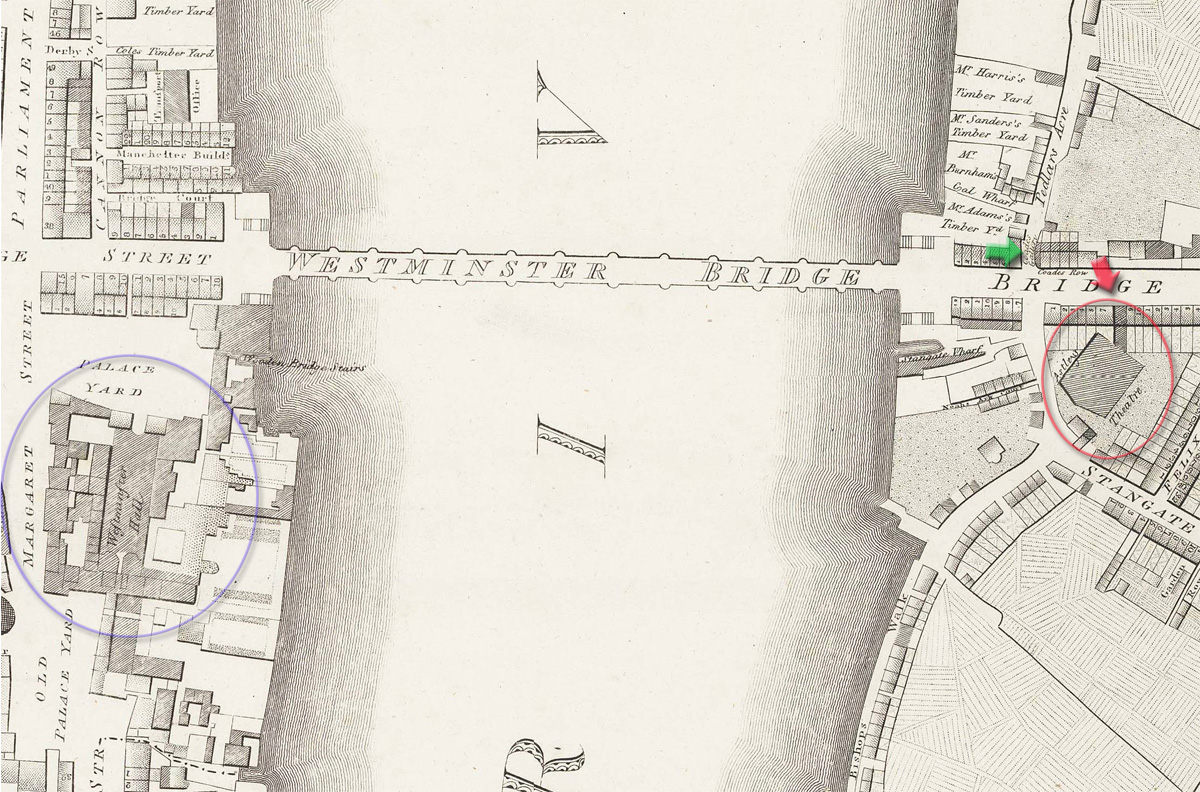
Astley's is cited as being the first modern circus in the world, with a fixed ring where the owner, Andrew Ducrow, and his family, would perform amazing acts of horsemanship, as we see the interior, below, in 1808:

But Astley's was much more than a permanent circus, as we see from this surviving playbill of 15 September 1826, preserved at Lambeth Archive:
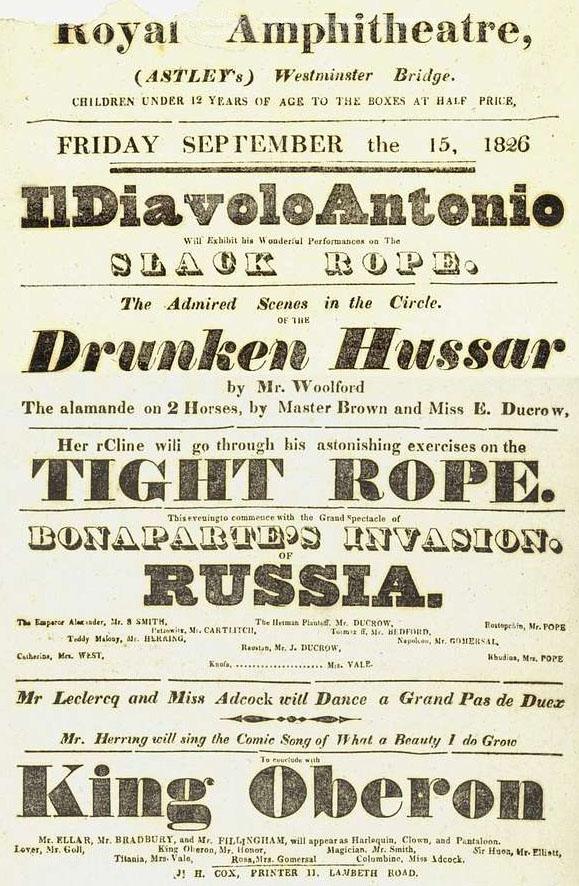
It's not one of Henry's playbills - which we hope to find some time in the future - but it illustrates the diversity of entertainment on show; Henry may have performed dancing, singing, comedy, playing a musical instrument, or serious acting in a child's part. Particularly popular at the time were dramatic historical re-enactments such as Bonaparte's Invasion of Russia which we see above.
Charles Dickens mentions Astley's in a comic passage in his novel The Old Curiosity Shop:

And Jane Austen writes about it in her 1816 novel Emma:

Here's the interior... unfortunately we don't know exactly what Henry did to entertain the crowd, but the arena was huge and it must have been fairly daunting for a boy of 9:
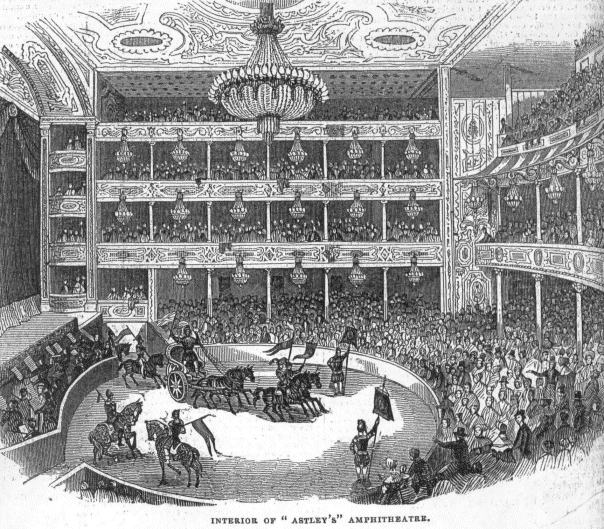
Astley's was on the east foot of Westminster Bridge:

And on the other side of the street to Astley's Amphitheatre on Westminster Bridge Road, in the map above, at the point of the green arrow, is Coade's Gallery:

Coade Stone was an artificial stone mixture like a high grade concrete which was hard, carried detail, and was readily moulded. Coade Stone was used for making statues, and it's a tribute to the quality of this material that so many pieces survive, such as the statue of Father Thames below, in London:

However good the product was, the company did not thrive, and went bust in 1833.
What's that got to do with our Henry?... Nothing. Hey, he might have crossed the road to look at the statues... no let's face it, nothing. Let's move on.
In fact, we've got nothing more to say about Henry for the next decade except that he was definitely pursuing his career as an actor.
1837 was the year Queen Victoria came to the throne, and on Saturday 02 December of that year, we get our next sighting of Henry, because he marries a young 17-year-old girl called Eliza Cooper:

The marriage is in the parish of St Mary-le-Bone, aka St Marylebone, pictured below in an engraving by the artist H. Wallis.
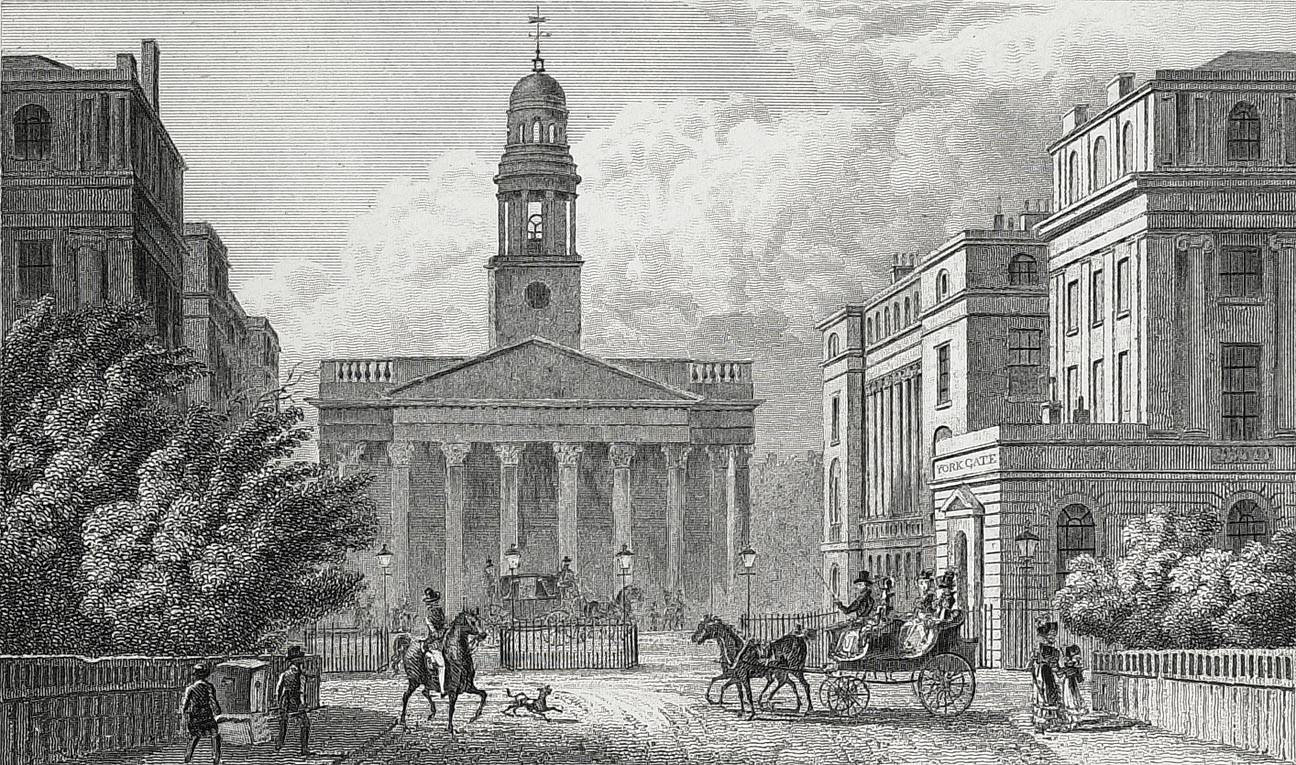
The picture we see above is drawn from the viewpoint of the yellow arrow in the map of Marylebone below. York Gate, on the right of the picture, was home to the Royal Academy of Music in Henry's day, and still is.

Where is Marylebone in London? It's on the 'New Road From Paddington' in the 1700's map below, which had become Marylebone Road by the time Henry was there. Henry's dwelling is in the green circle; it's not far from where he was born on Swallow Street:

But although the marriage is in the parish of St Mary-le-Bone, the wedding doesn't take place in the main church. The ceremony is actually held in the smaller church of St Mary Bryanston Square.

This church is at the viewpoint of the red arrow in the map, seen below c1830 and 2009, intentionally placed to provide a nice vista at the end of posh Bryanston Square:


Let's have another look at that marriage certificate of 1837. Henry's address is 2 Cirencester Place, circled in green in the map above. Eliza lives at 2 Little Titchfield Street, circled in red.

Little Titchfield Street is close to modern Oxford Circus. Here's how it looks today, though I'm sure you'll find it has changed completely since 1837. It's now home to campus buildings of the University of Westminster:

What else can we say about Henry's neighbourhood? Here's Cleveland Street [formerly Norfolk Street], where Charles Dickens had lived as a child in one of this row of houses in about 1816, at it's junction with Grafton Street:

The above photograph of Cleveland Street [c1900] is taken from the purple arrow, just around the corner Henry Partleton's dwellings in Cirencester Place:

And if Henry fancied a little stroll, he could admire nearby Fitzroy Square, built by the architect Robert Adam in 1798, which we see below from the viewpoint of the pale blue arrow. I like the little girl skipping and the maid carrying water in the right of the picture:

And from exactly the same viewpoint, if we transported Henry 128 years into the future, he would surely be quite amazed to see the Post Office Tower, completed in 1965, located in the light blue circle in the map:

Here's the tower in construction c1963, and the rotating restaurant at the top with its panoramic view of London.


I remember visiting the restaurant in the 1970's with my girlfriend and being disappointed to discover that it wasn't the whole top of the building which rotated, only the circular walkway under the tables!!!
So, if you'll forgive me, I'll take a little diversion to the top of the Post Office Tower Restaurant in 1979. It won't take a moment:

Mmmm, it looks right sophisticated and elegant on that brochure cover. It boasted fancy chefs and optimistically touted itself as...

And the menu was all in French and stuff:

But if we take a closer look at the cover of that brochure, it contains a bit of a giveaway: the restaurant was run by Butlin's, whose entire other business empire involved running cheap holiday camps.
In fact the restaurant had all the ambiance and atmosphere of a motorway service station, as I believe is apparent in these pictures:

Butlin's lease expired in 1980 and the restaurant closed. Pity. It seemed like a good idea.
How did we get here?... Let's get back to Henry Partleton at Cirencester Place. In c1838, he and Eliza start to give the family historian headaches, because they have a child, Henry, whose birth is apparently not recorded in the official records. State registration of births started in Britain in 1837; in the the early years there was no penalty for failing to register a birth, and this is a possible explanation for the missing record, especially as we know Henry and Eliza are always on the move.
And then comes the census of 1841. We can't find Henry, Eliza, or baby Henry anywhere in this census. Where are they? Despite some deep searching among possible mis-spellings, which are common in censuses, they all elude us.
From here onward, Henry and Eliza are regularly spotted in the records as travelling performers. Here's our first sight of one of them; it's Eliza, who performs, on her own, in South Shields on Monday 10 March 1851:
,%20Sunday,%20March%209,%201851;%20Issue%20650%20R.png)
Unfortunately, this clipping from The Era newspaper of 1851 doesn't specify what Eliza actually did to entertain her audience, but we know from later evidence that she is a musician in addition to being an actress.
The venue, the Scarborough Spa Music Saloon is not the famous, huge, spectacular Music Hall on Scarborough seafront. It's a small venue at 9 King Street, South Shields, which has borrowed the name, as we see it in a commercial directory of the time:

Here's a glimpse of King Street, South Shields:

South Shields is a town near Newcastle - a long way from London - at the location of the dark blue circle in the map below:

Three weeks later, Eliza is in Liverpool - red circle in the map - on the night of the 1851 census; Sunday 30 March:
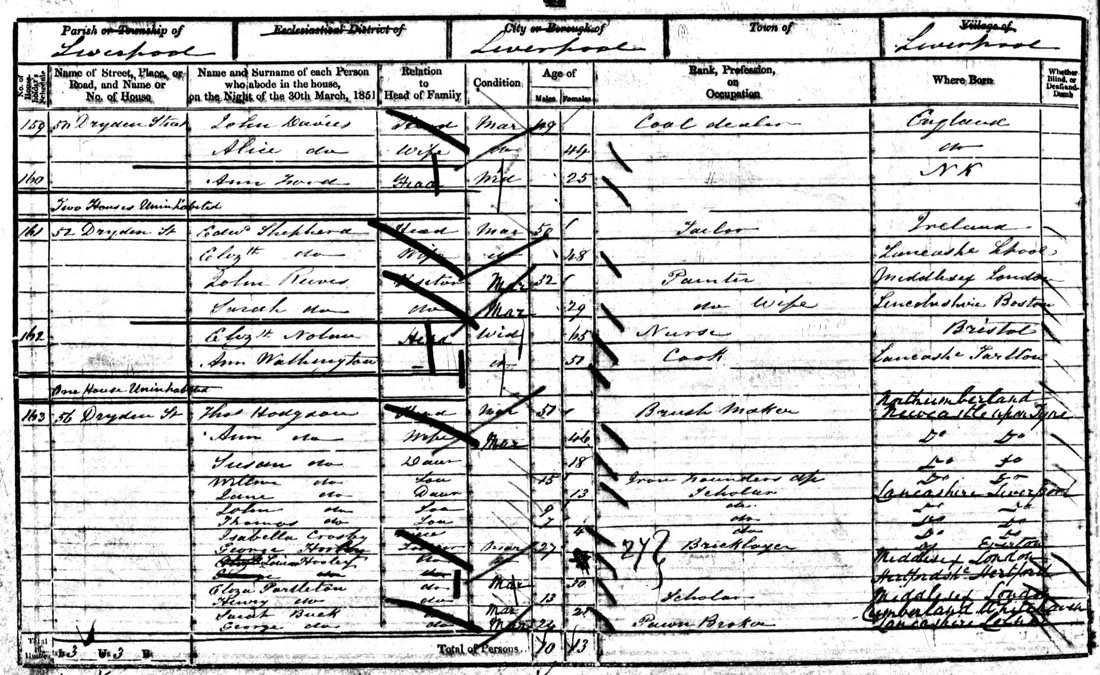
Eliza has young Henry Jr - aged 13 - with her. They are staying in lodgings on Dryden Street which we see below. Not a glamorous place:

But where is Henry Sr on the night of the 1851 census? ... He's in lodgings in Ashton-Under-Lyne near Manchester, at No 4 in the aptly-named Henry Square:

It's a rather poor scan, but look carefully and you'll see that his profession is declared to be 'Teacher of Dancing'.
Ashton-Under-Lyne is in the dark green circle in the map below:

In the 1861 census we actually see our two roving performers in the same place. They are lodging at 26 Birmingham Street, Stourbridge, in the yellow circle:
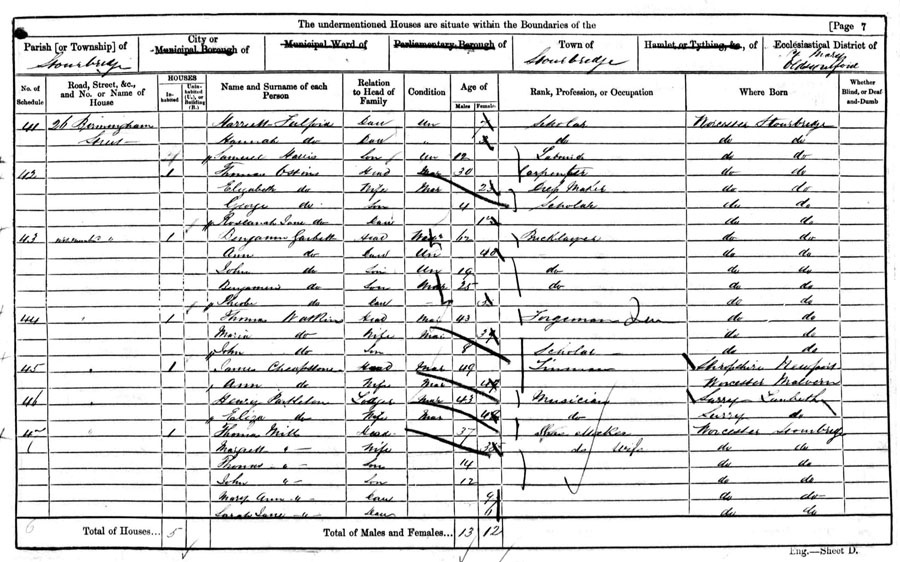
They both give their occupations as 'Musician'. But where is Henry Jr - who is now 23 years old - on the night of the census, which took place on 07 April 1861?
Well, he's not to be found in the UK census... Here's the record of his marriage to Selina Ann Matthews which took place on 08 June 1861 in Saint Philip, in the British Caribbean Island colony of Barbados. It's a long long way from Stourbridge, but it's plainly our Henry Jr:

But we won't talk about young Henry because he's got a page of his own. Suffice is to say that he fathers several children who never see their grandparents. We're going switch abruptly back to Britain, because the next record we find is for Henry and Eliza Partleton - who, on 23 October 1864, are performing together on stage in Dawley, a small coal-mining town in Shropshire:
,%20Sunday,%20October%2023,%201864%20R.png)
Here's Dawley High Street in the 1950's

Dawley is in the purple circle in the map below:

25 August 1867, we find Henry and Eliza Partleton together again - but this time they are among several husband-and-wife partnerships in South Wales:
,%20Sunday,%20August%2025,%201867%20R.png)
Dowlaisiis an iron-ore mining town in industrial South Wales:

We are beginning to see a pattern of Henry and Eliza performing in small theatres in mining towns. Here are two more pictures of the extremely unglamorous town ofiDowlais:
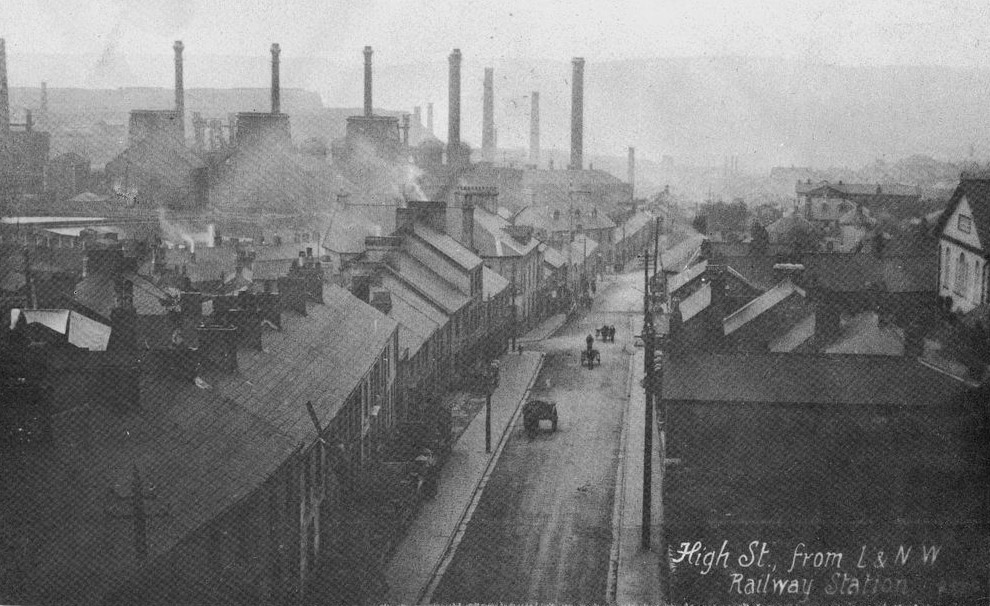
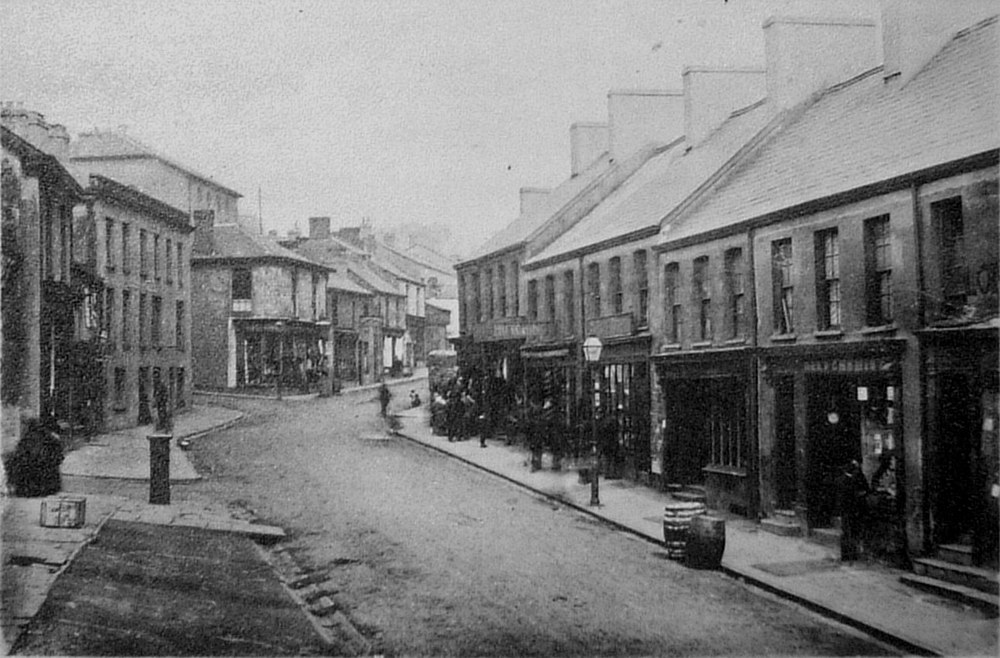
Let's have another look at that clipping:
,%20Sunday,%20August%2025,%201867%20R.png)
Henry and Eliza are acting together in the same bill in 1867 at the Prince of Wales Theatre. In the photograph below - many years later - we see DowlaisiHigh Street amidst waves of demolition - and, on the right, the Prince of Wales Inn, where Henry and Eliza performed, presumably in a hall at the back. Perhaps something similar to the white building at the left of the block, with the small hall behind it, which was an early cinema in the 20th century:

In case you are wondering where Dowlais is, it's near MerthyriTydfil, and it's circled gold in the map below:

Two years later - 18 September 1869 - we find Henry in Bacup, just north of Manchester, in the pale blue circle:
,%20Sunday,%20September%2026,%201869r.png)
Bacup was a typical northern English cotton-mill town. There always seems to be a film of smoky smog pervading the distance in these old photos. You can hardly see the end of the street:
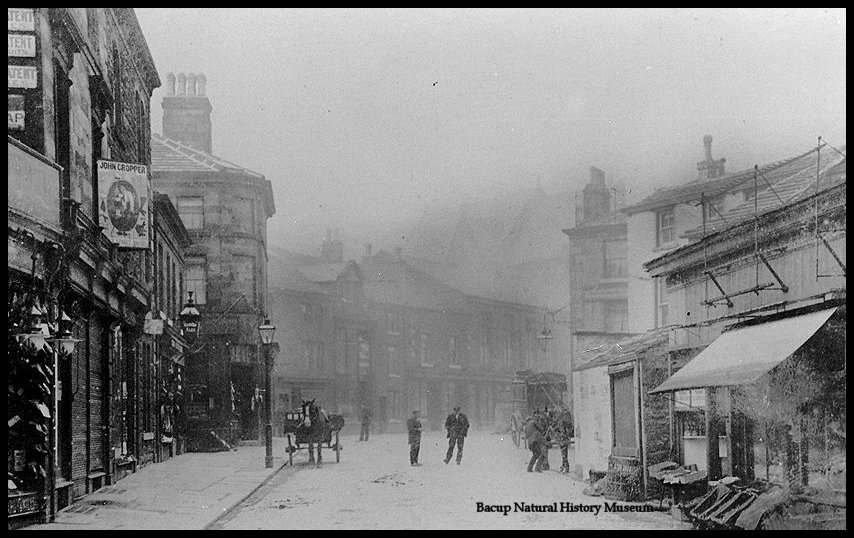
Two weeks later, 03 October 1869, we find Henry and Eliza still in Bacup, acting together in St Clair of the Isles:
,%20Sunday,%20October%203,%201869r.png)
Below we see the original novel which was adapted into the play performed by Henry and Eliza. It's a romance:

Here's the plot of St Clair of the Isles, as described by a critic in 1803:
"In the reign of James I. of Scotland, towards the middle of the 15th century, the events recorded in these volumes are supposed to have taken place. St Clair, and a party of his companions, are, by the cruel and unjust artifices of their relentless persecutors, rendered outlaws, and banished to the Isle of Barra, one of the Hebrides. After various occurrences during their stay in this place, at the succession of James II interest is made at court in their behalf, and the sentence of outlawry is reversed. They then return to the world, and pass the remainder of their days in the enjoyment of their freedom."
And here are some of the lines delivered by Eliza Cooper as Lady Roskelyn in Bacup in 1869:

And so we move on 15 months from Bacup, to the evening of 02 April 1871. It's time for another census... but again we find both Henry and Eliza absent from the record. Is this a symptom of their nomadic lifestyle? What's more, the newspaper reports dry up entirely for the rest of his life, though we know Henry is working for another 20 years.
So, let's move on another 10 years to 1881 and review where Henry's life has got him. He is now 67 and has only one child, Henry Jr, who is 44 and who has been living in Barbados for 20 years. Consequently, Henry Sr has three granddaughters, now aged 20, 16 and 14, living in Barbados. Has he ever seen them? Probably not.
The year being 1881, we should find Henry and his wife Eliza in the census held this year... but yet again they are missing. This is all rather unusual.
However, less than one year after the census, in 1882, Eliza does reappear in the records, and sad to say, it is in the form of her passing away:

Eliza dies at Brierley Hill near Birmingham, and we record her last circle in the map, in pink:

Henry Partleton's profession in Eliza's death certificate is declared to be 'Comedian'. Their address is recorded as Moor(e) Street, Brierley Hill. So perhaps we can go back to the England census of 1881 and see if they were living there... which we did. They weren't there.
Time flies. It's the 1891 census:
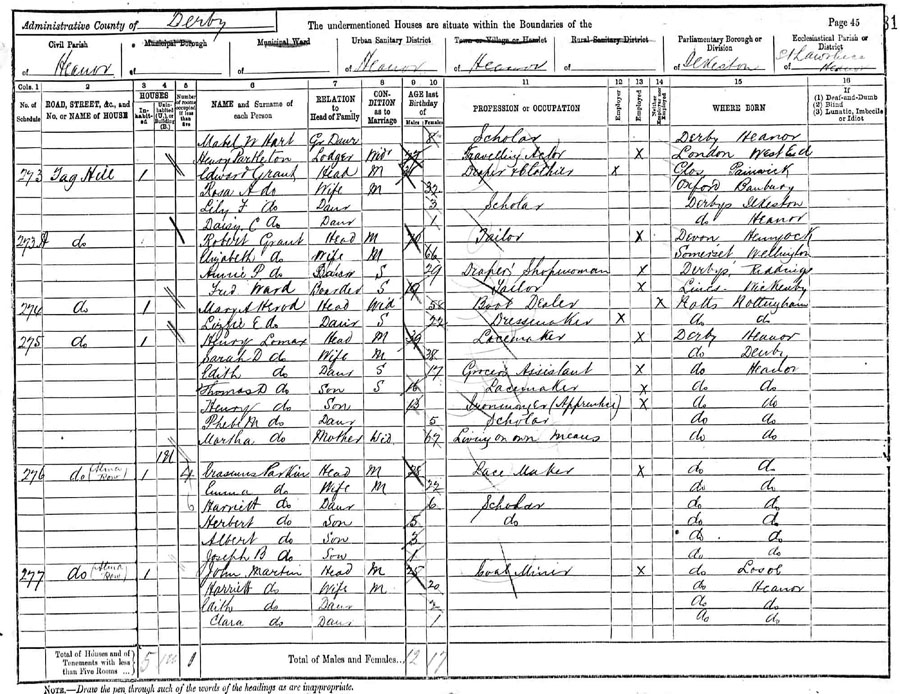
Henry Partleton is now 77 years old, on his own, and still working as a travelling actor. He's lodging at Tag Hill, in the small town of Heanor, Derbyshire - its another coal-mining area - and we can draw another circle in the map. I'm running out of colours - it's lime green:

But even Henry can't keep acting for ever. He lived a long life and passed away on 01 May 1893, aged 79, in Alfreton, Derbyshire, as recorded in his obituary in The Era Newspaper:
,%20Saturday,%20May%206,%201893r.png)
Alfreton is quite close to Heanor, so you'll find it also in the good old lime green circle. It's another mining town in the attractive Peak District of Derbyshire.
So, we're just about done with Britain. Both Henry Partleton and his wife Eliza have passed away, and their only son has gone to Barbados.
But we have one rather apt postscript to Henry's life:

What we see above is the death knell of Astley's Amphitheatre, where Henry had performed as a child. It had suffered fires in 1830 and 1841, was built back up again, and in 1871 the lease had been bought by showman George Sanger whence it became Sanger's Amphitheatre.
The landlord of the building was the Church of England, though its revenue agency the Ecclesiastical Commissioners. They accused Mr Sanger of 'running a disorderly house' and finally forced him out in 1893. Hence the terse letter written by George Sanger we see above:
'I beg to inform you I finally closed Sangers Amphitheatre Westminster Bridge Road on February 18th. I have since sold the remainder of the my lease in that property'.
Thus we see the Amphitheatre three years later, derelict and unloved. The Ecclesiastical Commissioners don't mind. They'll be making good money from the property which is in a prime location:

Nothing lasts for ever. Astley's Amphitheatre was demolished in 1896.
So we have finished with Britain, but we still have a lot to discuss, because in September 2008 the Partleton Tree was contacted by Tracy Smith, who lives in America and is descended from the Partletons in Barbados.
To make an amazing voyage of discovery to Barbados, and to follow the fortunes (or lack of them) of the Partleton family in that Caribbean island, click here.
If you enjoyed reading this page, you are invited to 'Like' us on Facebook. Or click on the Twitter button and follow us, and we'll let you know whenever a new page is added to the Partleton Tree:
If you’d like to help trace the tree further back, or find some of the missing information in the existing tree, send an email to partleton@yahoo.co.uk
Click here to return to the Partleton Tree 'Showbiz Partletons' Theatre Page
